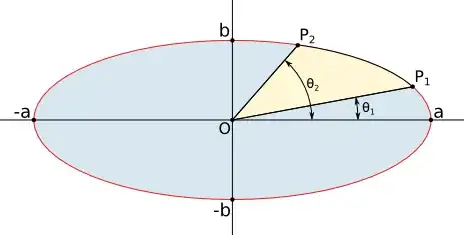A sector $P_1OP_2$ of an ellipse is given by angles $\theta_1$ and $\theta_2$.

Could you please explain me how to find the area of a sector of an ellipse?
Scale the entire figure along the $y$ direction by a factor of $a/b$. The ellipse becomes a circle of radius $a$, and the two angles become $\tan^{-1}(\frac ab\tan\theta_1)$ and $\tan^{-1}(\frac ab\tan \theta_2)$. The area of the original elliptical sector is $b/a$ times the area of the circular sector between these two angles, which is straightforward to find.
As I show in Evaluating $\int_a^b \frac12 r^2\ \mathrm d\theta$ to find the area of an ellipse the area of an ellipse given its central angle is:
$A(\theta) = \frac{1}{2} a b \tan ^{-1}\left(\frac{a \tan (\theta )}{b}\right)$
for $0\leq\theta\leq2\pi$, so the area of the sector in question is:
$A\left(\theta _2\right) - A\left(\theta _1\right)$
or:
$\frac{1}{2} a b \left(\tan ^{-1}\left(\frac{a \tan \left(\theta _2\right)}{b}\right)-\tan ^{-1}\left(\frac{a \tan \left(\theta _1\right)}{b}\right)\right)$
which sadly does not appear to simplify any further.
Using polar elliptical coordinates:$$x=a\rho cos(\theta)$$ $$y=b \rho sin(\theta)$$ the part of the plane enclosed from the ellipse is $$\{(\rho,\theta):0\le \rho \le 1,\theta\in(0,2\pi)\}$$ the Jacobian of the inverse transform is: $$J=\begin{bmatrix}a cos(\theta) & -a \rho sin(\theta) \\ b sin(\theta) & b \rho cos(\theta)\end{bmatrix}$$ so the area of a sector is: $$\int_{\theta_1}^{\theta_2}d\theta \int_0^1 d\rho a b\rho$$
Because the integral in $d\rho$ is $\frac{1}{2}ab$ the result is $$\frac{1}{2}ab(\theta_2-\theta_1)$$